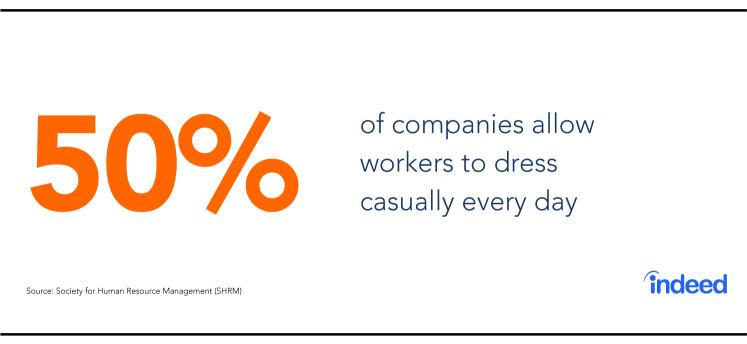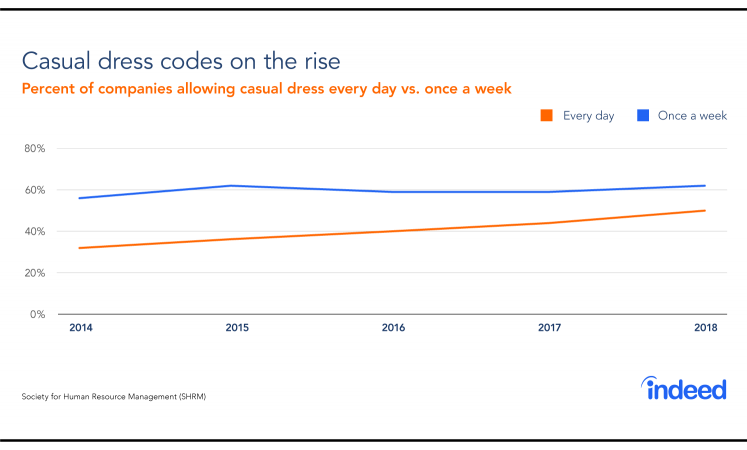How a Relaxed Dress Code Can Help Attract Top Talent

What we are expected to wear to work is ingrained in us at a very young age. We’re taught that firefighters wear brimmed helmets, doctors wear white coats and businesspeople wear suits.
But as the workplace has modernized, so have our outfits. Over time, what people wear to work has evolved from once-mandatory skirts and ties to the “business casual” era to today’s increasingly casual attire.
Some employers shudder at the thought of their employees coming to work in T-shirts and yoga pants, but studies show that most workers prefer a relaxed dress code. This can become a cost-free perk to attract top talent — but is a relaxed dress code right for your company? Here are some considerations to help you decide.
Casual dress on the rise


The percentage of U.S. companies that allow employees to wear casual dress every day has rapidly increased, jumping from 32% to 50% in just five years. What’s more, almost two-thirds (62%) of companies now allow for casual clothing at least one day per week.
And it’s not just small startups; large companies, including Target and Virgin Atlantic, have recently made the news for softening dress codes. Even Wall Street giant Goldman Sachs has relaxed their formal dress code for a more flexible one.
Of course, there is still a range of “acceptable” work wear, and not everyone is a fan of the push toward a more relaxed dress code. Though norms are changing rapidly, it was only a few years ago that Mark Zuckerberg made a splash by showing up for investor meetings in a hoodie.
Consider the nature of your business when determining whether a casual dress code makes sense for you. Companies with formal client meetings, such as law firms, or that want to put their best foot forward in difficult times, such as funeral homes, may want to stick to a stricter dress code.
Casual dress code may help attract talent
“Casual Fridays” and business-casual workwear were popularized in the 1990s as an inexpensive way to give employees a small benefit. But even business casual can seem archaic in an era when many professionals now wear T-shirts and sneakers to the office.
Tech firms and startups have led the way in letting employees wear what they want since the 1980s. In an effort to compete with this rapidly growing sector, “casual every day” is now being used as a recruiting tactic at many companies — a smart move for those that can swing it, given that 61% of job seekers in a recent U.K. study have a negative perception of companies that enforce dress codes. Many speculate that millennials are driving the trend toward a more relaxed dress code, making it an especially good marketing tactic for those targeting this key demographic.
For many companies, the switch to casual clothes can be a simple change that pays big dividends. Some are incorporating casual dress as part of a larger cultural change; JPMorgan Chase, for example, created a separate office in New York for their tech staff, complete with whiteboard walls, foosball tables — and no ties in sight.
Though everyone has individual preferences regarding what to wear, employees highly value the opportunity to reflect their authentic selves in the way they dress. Those who say they’re unhappy at work are twice as likely as the overall population to say their work attire doesn’t reflect their true personality (55%, compared to 29% overall). Having a relaxed dress code can help workers be both more expressive and happier on the job.
If you believe that offering a casual dress code could help attract talent, make sure you publicize it in materials about company culture and in job descriptions.
Determine clear boundaries
Some companies may fear that loosening dress codes will plunge their staff into a world of flip-flops and crop tops; in fact, one-quarter of workers in a recent study say their dress code is too lenient. However, just because you have a relaxed dress code doesn’t mean you can’t provide guidelines. Make a written dress code available to all employees that clearly outlines what’s out of bounds, whether it’s open-toed shoes or torn jeans.
The goal is for workers to meet a standard of professionalism in their dress, not to dictate how people should present themselves. When drafting dress-code guidelines, be careful to avoid explicitly gendered or cultural rules — some companies still discriminate against employees by requiring heels and makeup for women or by banning cornrows. Bring in a diversity and inclusion expert for support, if needed.
Onboard with care
New employees will bring a variety of experiences with them, including what they are accustomed to wearing on the job — and not everyone has the same expectations of what is appropriate. Communicate guidelines early and often; you can even tell candidates what to wear to their job interview so they understand the dress code before they start.
Whenever possible, explain the reasoning behind your dress code, such as attire that is required for safety-oriented or professional reasons. However you decide to manage dress codes in your office, take heart in social norms; most people don’t want to hinder their career opportunities by dressing inappropriately and will follow your lead.
Casual dress codes won’t work for every company and scenario; many clients would be jarred if their lawyer showed up for court in a T-shirt. But at many workplaces, there’s no need to require formal dress — and top talent who value comfort will be drawn to this.
Follow our Recruiter Blog and Social Media:

